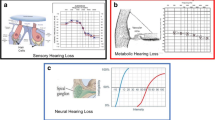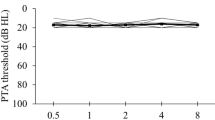Abstract
Purpose
Cochlear synaptopathy or hidden hearing loss is difficult to assess due to the lack of sensitivity with standard audiological tests. Poor speech perception, especially in the presence of noise or tinnitus, is the most common complaint of these patients. The purpose of this systematic review is to identify articles in peer-reviewed journals that used behavioral measures in the effective assessment of cochlear synaptopathy or hidden hearing loss.
Methods
The manuscripts were searched in various international databases, and the manuscripts were screened based on titles, abstracts, and full-length content. A total of 14 human studies were selected after the appropriate exclusion of other articles.
Results
Results showed that high-frequency audiometry could be used for the early identification of cochlear synaptopathy. The tone in noise detection test can also be added in the test battery along with speech perception in noise. The amplitude modulation detection test, interaural phase difference, and differential sensitivity tests require more research before using them for the assessment of cochlear synaptopathy or hidden hearing loss.
Conclusions
Self-reports and questionnaires also help in determining the extent of noise exposure.

Similar content being viewed by others
References
Kujawa SG, Liberman MC (2009) Adding insult to injury: cochlear nerve degeneration after “temporary” noise-induced hearing loss. J Neurosci 29(45):14077–14085
Viana LM, O’Malley JT, Burgess BJ, Jones DD, Oliveira CACP, Santos F et al (2015) Cochlear neuropathy in human presbycusis: Confocal analysis of hidden hearing loss in post-mortem tissue. Hear Res [Internet]. 327:78–88. https://doi.org/10.1016/j.heares.2015.04.014
Schmiedt RA, Mills JH, Boettcher FA (1996) Age-related loss of activity of auditory-nerve fibers. J Neurophysiol 76(4):2799–2803
Sergeyenko Y, Lall K, Charles Liberman M, Kujawa SG (2013) Age-related cochlear synaptopathy: an early-onset contributor to auditory functional decline. J Neurosci 33(34):13686–13694
Kujawa SG, Liberman MC (2015) Synaptopathy in the noise-exposed and aging cochlea: primary neural degeneration in acquired sensorineural hearing loss. Hear Res [Internet]. 330:191–199. https://doi.org/10.1016/j.heares.2015.02.009
Liberman MC, Epstein MJ, Cleveland SS, Wang H, Maison SF (2016) Toward a differential diagnosis of hidden hearing loss in humans. PLoS ONE 11(9):1–15
Grose JH, Buss E, Hall JW (2017) Loud music exposure and cochlear synaptopathy in young adults: isolated auditory brainstem response effects but no perceptual consequences. Trends Hear 21:1–18
Stamper GC, Johnson TA (2015) Auditory function in normal-hearing, noise-exposed human ears. Ear Hear 36(2):172–184
Stamper GC, Johnson TA (2015) Letter to the Editor: examination of potential sex influences in Stamper, G. C., & Johnson, T. A. auditory function in normal-hearing, noise-exposed human ears, ear hear, 36, 172–184. Vol. 36. Ear Hear 2015:738–740
Johannesen PT, Buzo BC, Lopez-poveda EA (2019) Evidence for age-related cochlear synaptopathy in humans unconnected to speech-in-noise intelligibility de fi cits. Hear Res [Internet]. 374:35–48. https://doi.org/10.1016/j.heares.2019.01.017
Paul BT, Waheed S, Bruce IC, Roberts LE (2017). Subcortical amplitude modulation encoding deficits suggest evidence of cochlear synaptopathy in normal-hearing 18–19 year olds with higher lifetime noise exposure. J Acoust Soc Am 142(5):EL434–40
Prendergast G, Couth S, Millman RE, Guest H, Kluk K, Munro KJ et al (2019) Effects of age and noise exposure on proxy measures of cochlear synaptopathy. Trends Hear 23:1–16
Prendergast G, Millman RE, Guest H, Munro KJ, Kluk K, Dewey RS et al (2017) Effects of noise exposure on young adults with normal audiograms II: behavioral measures. Hear Res [Internet]. 356:74–86. https://doi.org/10.1016/j.heares.2017.10.007
Beach EF (2018) Hidden hearing loss in humans: cochlear synaptopathy is superseded by cognitive effects when listening to speech in noise. ENT Audiol News 27(1):84–85
Kamerer AM, Aubuchon A, Fultz SE, Kopun JG, Neely ST, Rasetshwane DM (2019) The role of cognition in common measures of peripheral synaptopathy and hidden hearing loss. Am J Audiol 28(4):843–856
Barbee CM, James JA, Park JH, Smith EM, Johnson CE, Clifton S et al (2018) Effectiveness of auditory measures for detecting hidden hearing loss and/or cochlear synaptopathy: a systematic review. Semin Hear 39(2):172–209
Grinn SK, Wiseman KB, Baker JA, Le Prell CG (2017) Hidden hearing loss? No effect of common recreational noise exposure on cochlear nerve response amplitude in humans. Front Neurosci 11(SEP):465
Paul BT, Bruce IC, Roberts LE (2017) Evidence that hidden hearing loss underlies amplitude modulation encoding deficits in individuals with and without tinnitus. Hear Res [Internet] 344:170–182. https://doi.org/10.1016/j.heares.2016.11.010
Ralli M, Greco A, De Vincentiis M, Sheppard A, Cappelli G, Neri I et al (2019) Tone-in-noise detection deficits in elderly patients with clinically normal hearing. Am J Otolaryngol Head Neck Med Surg [Internet] 40(1):1–9. https://doi.org/10.1016/j.amjoto.2018.09.012
Tange RA, Dreschler WA, van der Hulst RJAM (1985) The importance of high-tone audiometry in monitoring for ototoxicity. Arch Otorhinolaryngol 242(1):77–81
Paul BT, Bruce IC, Roberts LE (2018) Envelope following responses, noise exposure, and evidence of cochlear synaptopathy in humans: correction and comment. J Acoust Soc Am 143(6):EL487–EL489
Fulbright ANC, Le Prell CG, Griffiths SK, Lobarinas E (2017) Effects of recreational noise on threshold and suprathreshold measures of auditory function. Semin Hear 38(4):298–318
Smith SB, Krizman J, Liu C, White-Schwoch T, Nicol T, Kraus N (2019) Investigating peripheral sources of speech-in-noise variability in listeners with normal audiograms. Hear Res 371:66–74
Megarbane L, Fuente A (2020) Association between speech perception in noise and electrophysiological measures: an exploratory study of possible techniques to evaluate cochlear synaptopathy in humans. Int J Audiol [Internet] 59(6):427–433. https://doi.org/10.1080/14992027.2020.1718783
Le Prell CG (2019) Effects of noise exposure on auditory brainstem response and speech-in-noise tasks: a review of the literature. Int J Audiol 58:S3-32
Stone MA, Moore BCJ, Greenish H (2008) Discrimination of envelope statistics reveals evidence of sub-clinical hearing damage in a noise-exposed population with “normal” hearing thresholds. Int J Audiol 47(12):737–750
Acknowledgements
The authors acknowledge with gratitude Prof. M Pushpavathi, Director, All India Institute of Speech and Hearing affiliated to University of Mysore, for permitting to conduct the study at the institute. The authors also like to acknowledge the participant for co-operation.
Funding
There is no funding by any agency for the manuscript.
Author information
Authors and Affiliations
Contributions
PL was involved in study design, data collection, analysis of the results, interpreting and writing the manuscript; PP was involved in study design, data collection, analysis of the data, interpretation and writing the manuscript.
Corresponding author
Ethics declarations
Conflict of interest
The authors report no conflicts of interest. The authors alone are responsible for the content and writing of the paper.
Ethical approval
Ethical approval was obtained from the All India Institute of Speech and Hearing (AIISH) Ethical Review board for carrying out the study.
Ethical standards
The manuscript adheres to the ethical standards according to the Declaration of Helsinki.
Informed consent
Informed consent was obtained from the patient to participate in the study.
Human/animal rights statement
In the present study, all the testing procedures were carried out on humans using non-invasive techniques, adhering to the guidelines of the Ethics Approval Committee of the institute. All the procedures were explained to the participants, and informed consent was taken from all the participants of the study.
Additional information
Publisher's Note
Springer Nature remains neutral with regard to jurisdictional claims in published maps and institutional affiliations.
Rights and permissions
About this article
Cite this article
Lokwani, P., Prabhu, P. Efficacy of behavioral audiological tests in identifying cochlear synaptopathy: a systematic review. Eur Arch Otorhinolaryngol 279, 577–594 (2022). https://doi.org/10.1007/s00405-021-06927-x
Received:
Accepted:
Published:
Issue Date:
DOI: https://doi.org/10.1007/s00405-021-06927-x




